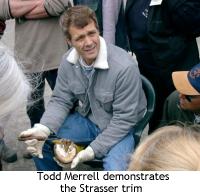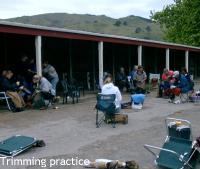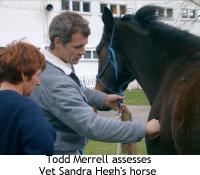

|
A r t i c l e s A n d C a s e
S t u d i e s
Canadian Strasser Hoofcare Specialist Todd Merrell teaches an holistic approach to equine management - from the hooves up. Teresa Maxwell reports on his Hoofcare Seminar recently held in Paeroa.
September, 2002

Strasser equine hoofcare is much more than simply removing the shoes and applying a correct physiological hoof trim, according to Strasser Certified Hoofcare Specialist and Instructor Todd Merrell.
Strasser hoofcare is an holistic approach to horse management, from the hooves up. It's about how to care for your horse according to it's ecological needs, resulting in a much healthier and truly sound horse, - something not possible with the damaging effects of shoes, rugs and stabling.
Todd Merrell, of British Columbia, Canada, visited New Zealand last month to hold two Strasser Hoofcare courses in Paeroa.
During the courses, held over a week-long period, Todd Merrell showed the 40 participants not only how to correctly trim horses hooves, but that the condition of a horse's hooves played a vital role in the overall health of the horse.
We learned how shoeing a horse, or having an incorrect hoof trim results in tightness and pain in the muscles, behaviour problems, and even confirmation problems, that are immediately improved or or completely fixed by applying Strasser's physiologically correct hoof trim.
We also learned how the Strasser method of hoof trimming and horse care also fixes common hoof ailments such as navicular, laminitis, hoof cracks, contraction, ring bone, ossifications and brittle hooves - all caused by shoeing and/or incorrect trimming and unnatural living conditions.
The Strasser Method
Todd Merrell is one of four instructors worldwide qualified to teach Dr. vet med. Hiltrud Strasser's hoofcare methods. Dr Strasser is a veterinarian who, for nearly twenty years, has been studying and researching the causes and cures of lameness and other common health problems of domestic horses.
She has based her research on the wild horse and has defined the optimum barefoot model. Using her research she has developed a complete system for the care of horses in a manmade environment which minimizes the many health problems currently found in conventional boarding.
The orthopedic methods she has developed have yielded unprecedented success in equine lameness rehabilitation. More importantly her techniques are successful as a daily method for maintaining horses in optimum health.
In 1993, she opened the 'Institute for Hoof Health' and ESHOP (European School for Hoof Orthopedics), a center for study and learning. Having established her methods in North America, Europe and Britain, Strasser opened in 2002 to sold out audiences in Australia and New Zealand.

The Paeroa Clinic
In the first Paeroa course, "Basic Strasser Hoofcare", Todd Merrell took participants through two days of intensive theory, detailing Strasser's Natural Living Conditions, ie; the importance of ample movement for the horse (optimum 10-15 miles per day), a herd environment, daily water to the hooves, adequate shelter and resting places, no rugs or wraps, and no shoes.
He also taught us the results of Strasser's research into the hoof: the effects of shoeing, including the incredible amount of damage shoeing causes to the hoof, such as navicular, laminitis, contraction, inhibited traction, circulation and shock absorption and the damage this does to the rest of the horse, eg; back problems, muscle pain, confirmation faults.
For example, we learned that a shod horse walking on concrete has many more times shock than a physiologically correct trimmed horse trotting on concrete. We also learned that the coffin bone of a jumping horse can have up to a ton of pressure on it, which is a lot considering you can easily smash a coffin bone with a hammer.
With these kinds of pressure on the hoof, it is important that jumping and performance horses have a physiologically correct hoof trim for optimum hoof health and be ridden without shoes, as shoes impair the horse's unique shock absorption capabilities.
A cadaver hoof trimmed by Todd Merrell, left, and a dissection of
the same hoof, right. Click on the images for a larger view
Finally, he took us through Strasser's correct physiological trim, which involves ensuring that the coffin bone is parallel to the ground, which means the weight is distributed evenly on the hoof capsule, the hoof wears evenly and functions correctly with maximum hoof mechanism.
In other words, when the horse puts weight on its hoof, the hoof is able to expand, allowing maximum circulation within the hoof and the rest of the horse - essential for optimum health.
If the horse is shod or has an incorrect trim, the hoof will not expand when the horse puts weight on it, and may even contract, which is unnatural, inhibits circulation and causes deformity in the hoof and health problems for the horse.
The main cause of this lack of expansion or lack of hoof mechanism is shoeing and/or excessive bars or sole, which puts pressure on the bones inside the hoof (causing such things as navicular and laminitis) and puts pressure on the outside of the hoof (causing such things as hoof cracks).

Assessment of Horses
On the third day of the first seminar and the following two days of the "Advanced Strasser Seminar", Todd demonstrated the Strasser trim on cadaver hooves. He then made assessments of horses brought to the clinic by clinic participants.
Here's where it got really interesting. Todd showed us how to assess the whole horse in relation to what was going on with it's hooves. Simply looking at how the horse was standing, we were able to see where it was in pain and how it compensated for that pain.
"Standing Under"
Most of the horses were "standing under" which means their cannon bones were not perpendicular to the ground. One young horse was particularly bad, described as "standing like a goat on a rock".
This common stance, traditionally known as a "confirmation fault" is due to pain in the heel region of the hoof, which is caused by high heels, contracted heel bulbs and long bars that are often growing over the sole. The horse tries to avoid the pain in the heel by putting more weight on the toe, resulting in the horse "standing under".
After the owner carefully removed excessive bar and sole material in accordance with the Strasser trimming method Todd Merrell taught us, the horse was instantly able to stand straighter and consequently moved better as its muscles were freed up for movement, rather than being tight and sore from compensating for sore heels.
Muscle Tightness caused by hoof pain
One interesting case was a beautiful Hanoverian dressage mare, who had been putting so much weight on the toe, the toes were wearing off, resulting in a very steep hoof, particularly in the hind hooves.
Todd pointed out to us the tightness in the mare's hindquarters and hamstrings, which had resulted in overdeveloped muscles. This was due to the horse using these muscles to compensate for pain in the heels, ie; trying not to put weight on the sore heels.
Using accupressure or "trigger" points, Todd was able to confirm where the horse was sore. Upon putting light pressure on a trigger point in the hindquarters, the horse became agitated, swishing its tail and threatening to kick.
After the owner did a Strasser trim, the horse made no response to pressure in the same trigger point. Todd was able to push half his thumb into the trigger point and the horse just stood there. We were all a bit blown away by this as we had not long before witnessed the threatening behaviour of the mare with only light pressure on the same point just half an hour beforehand.
Todd Merrell demonstrates how to hold the hoof of a horse with
muscle tightness
Todd Merrell explained that this was because the mare no longer had to use its
hindquarter muscles to compensate for pain in the hoof. In other words, she was
able to stand properly and she could relax her sore, overworked muscles.
He also
showed how to hold a horse's hoof to accommodate for such muscle tightness so
that the horse is more comfortable while trimming (see pictures above)
Dissection of Hooves
Some of the cadaver hooves were dissected to show what damage had been done inside the hoof due to incorrect trimming and/or shoeing. We learnt that a horse shod young, will have a deformed coffin bone, as contraction causes it to develop with little or no solar concavity. In other words, flat feet, common among many New Zealand thoroughbreds and show horses.
Flatfootedness
One bone set available to the class demonstrated this flat-footedness, with the coffin bone having been contracted and flat, due to shoeing.
Atrophied Frog
We also learned from the dissected hooves that the main artery that feeds blood to the frog of the hoof is situated at the base of the bars. If the bars are overgrown, the artery is pinched, constricting the blood supply to the frog. In this situation, the frog is atrophied and small, instead of being wide, tough and leathery.
Barefoot in NZ
The Strasser method of trimming and riding horses "barefoot" has fast become popular in New Zealand. Todd Merrell said he expected Strasser's methods of horse management to take off in this country, due to New Zealanders' willingness to "give it a go" themselves. Also most horses are kept in more or less natural conditions (ie; at pasture), in comparison to European countries, where many horses are stabled 24/7.
Since Dr Strasser gave a seminar north of Auckland in January, 2002, many people have opted to go "barefoot" with their horses, and are successfully competing in all areas, such as dressage, jumping, and endurance, as well as pleasure horses and trekking.
Many have noted increased balance and performance, due to the horse no longer using it's muscles to compensate for soreness in the hoof and a better quality hoof horn. It was also mentioned that barefoot horses were performing with better balance due to the coffin bone being parallel to the ground, which is an essential grounding factor for the muscular-skeletal system that is commonly overlooked.
Who is Todd Merrell?
Todd Merrell is working directly with Dr. Strasser on her video and DVD training programs and heads Dr Strasser's North American operations. The first of a series of videos, called: "Optimum Hoof Form - The Basic Trim" has been produced and will be available in New Zealand soon at www.naturalhoof.co.nz. Other videos to be produced include "Transition to Barefoot" and "Confirmation".
Todd Merrell works daily with the Strasser method at his Langley, BC location and has the first rubber floor clinic set-up in North America which he is using for case studies for the Strasser series of videos. All current Strasser hoofcare students have the benefit of access to this facility and Todd Merrell for training which is offered as part of the Strasser Hoofcare Specialist training program in North America. The Strasser Hoofcare Specialist programme is also available in Australia for Australasian students. Only Certified Strasser Hoofcare Specialists, who have completed the one-year programme are qualified to perform the Strasser trim professionally.
Find out more
Dr. Strasser is the author of several text books on lameness and healing,
reference books on natural boarding for horses, and many articles for both horse
and veterinary journals. Her books, "A Lifetime of Soundness" and "Shoeing, A
Necessary Evil" are now available in New Zealand at
www.naturalhoof.co.nz/shop or phone 0064 7 868 3881 for more information.
Submit an Article or Case Study
The more we share information, the better off our
horses are going to be. If you'd like to share your
story, please email the
editor.
Disclaimer: Natural Hoof
reserves the right to change or edit any part of
all articles and case studies submitted to this
website. Natural Hoof does not take any
responsibility for the content of any articles
and/or case studies and/or any misapplication of the information presented in any articles. Natural Hoof presumes readers consult a professional for more information about any topic covered in any Natural Hoof article.
Home | Articles | Study Groups | Clinics-Events | Brag | Classifieds |
Order | Links


|
|









